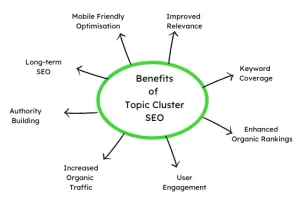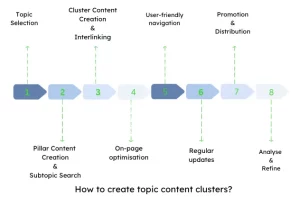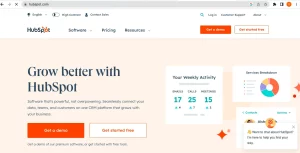Guide to Create Topic Cluster for Content Marketing
Amidst high competition, businesses and content creators strive to make their voices heard. And everytime they need to check whether their messages reach the right audience or not? Here comes Topic Cluster for content marketing, let’s know more about it.
Content creation is not the job when you have to market your products or services. It is important to check whether the content is impressive enough to captivate the search engines as well as the readers.
The best way to keep the actions and goals aligned is to develop content clusters.
Content clusters are developing a harmonious strategy that unlocks the potential of the content.
Let us dive in deep to understand what is a cluster for content marketing.
What is Topic Cluster?
Topic clusters, also known as topic clusters or cluster content strategies, are used in marketing to organise and optimise website content around specific topics.
A content cluster consists of a pillar piece of content, a comprehensive and authoritative article or page on a particular subject, and multiple related subtopics or supporting articles that link to the pillar content.
- The idea behind content clusters is to create a network of interlinked content that demonstrates expertise and provides comprehensive information on a given topic.
- This approach helps search engines understand the relevance and depth of the content, improving the website’s visibility in search engine results pages (SERPs) and overall organic traffic.
- The pillar content serves as the cluster’s main hub or central piece, covering the core topic in-depth and offering valuable insights. Each supporting article, often referred to as cluster content, explores a subtopic or related aspect of the main topic, providing more specific information and linking back to the pillar content. These internal links help search engines recognize the relationships between the different pieces of content within the cluster and contribute to higher rankings.
- Content clusters are an effective SEO strategy because they allow websites to rank for multiple long-tail keywords and increase organic visibility. By creating a comprehensive resource on a particular topic, websites can attract a wider audience and establish themselves as authoritative sources in their respective fields.
- To create content clusters, it is important to conduct thorough keyword research, identify relevant subtopics, and plan the organisation and interlinking of the cluster.
- By strategically connecting the pillar and cluster content, websites can create a cohesive content structure that enhances user experience and search engine optimization.
Benefits of Topic Clusters SEO
These are the benefits of topic clusters SEO:

Improved Relevance
Topic clusters allow you to create a comprehensive resource on a specific subject, signalling to search engines that your content is relevant and authoritative.
Keyword Coverage
By creating pillar content and cluster content that target different long-tail keywords within a topic, you can increase your visibility for a broader range of search queries.
Enhanced Organic Rankings
The interlinking structure of topic clusters helps search engines understand the relationships between your content pieces, potentially leading to higher rankings for relevant search queries.
User Engagement
Topic clusters provide a seamless user experience by offering comprehensive information and easy navigation between related content. This can lead to more extended website visits, increased page views, and improved user engagement metrics, all positive signals for SEO.
Increased Organic Traffic
As your topic cluster gains visibility in search engine results pages (SERPs), you have the potential to attract more organic traffic from users interested in your topic. The more comprehensive and valuable your content, the more likely users will return and share it with others, boosting your traffic.
Authority Building
By creating a network of related content within a topic, you establish your website as an authoritative resource in the eyes of search engines and users. This can lead to more backlinks, social shares, and overall credibility, improving SEO.
Long-Term SEO Value
Topic clusters are designed to be evergreen content assets. Once established, they can continue attracting organic traffic and building authority over time. Regularly updating and expanding your cluster content can help maintain its relevance and long-term SEO value.
Mobile-Friendly Optimisation
Topic clusters can be optimised for mobile devices, catering to the increasing number of internet users through smartphones and tablets. Mobile-friendly content and seamless navigation contribute to a positive user experience, a ranking factor for search engines.
Also Read: Step-by-Step Guide Write a High Quality Blog Post
How to Create Content Clusters for Content Marketing?
Creating content clusters for content marketing involves several steps. Here’s a general framework to guide you through the process:

Topic Selection
Choose a broad topic or subject area that aligns with your target audience’s interests and expertise. It should be a topic you can cover comprehensively, with enough subtopics to create a cluster.
Pillar Content Creation
Develop a comprehensive, high-quality pillar content piece that serves as the core resource for the topic. The pillar content should cover the main topic in-depth and provide valuable insights. Ensure it is well-researched, well-written, and optimised for SEO.
Subtopic Research
Conduct keyword research and identify relevant subtopics related to the main topic. These subtopics should be narrower in scope and provide more specific information. Aim for long-tail keywords with moderate search volume and low competition.
Cluster Content Creation
Create individual cluster content pieces for each subtopic. These should be well-written, informative articles or pages that address specific aspects or subtopics of the main topic. Ensure each cluster content piece is optimised for the corresponding long-tail keyword.
Interlinking
Strategically interlink the cluster content pieces to the pillar content and vice versa. Use anchor text that includes relevant keywords and contextualises the linked content. This interlinking structure helps search engines understand the relationships between the content pieces within the cluster.
On-Page Optimisation
Optimise each piece of content, including the pillar and cluster content, with relevant keywords, meta tags, headers, and images. Pay attention to readability, formatting, and user experience.
Ensure that your content cluster is easy to navigate for users. Incorporate clear menus, related post sections, or topic-specific landing pages to guide users through the pillar and cluster content.
Regular Updates
Continuously update and expand your content cluster. Add new cluster content pieces as you identify additional subtopics or new developments in your field. Update the pillar content periodically to ensure it remains relevant and up to date.
Promotion and Distribution
Once your content cluster is ready, promote and distribute it through various channels such as social media, email newsletters, and relevant online communities. Encourage engagement, sharing, and backlinking to boost its visibility and reach.
Analyse and Refine
Monitor the performance of your content cluster using web analytics tools. Track metrics such as organic traffic, engagement, and conversions. Analyse the data to identify areas for improvement and refine your content cluster strategy accordingly.
Brand Example That Developed Topic Clusters For Content Marketing
One example of a brand successfully implementing content clusters is HubSpot, a leading inbound marketing and sales software company. HubSpot has built a robust content marketing strategy centred around topic clusters to attract and engage its target audience.

HubSpot’s pillar content revolves around broad topics such as inbound marketing, sales enablement, customer relationship management (CRM), and more. They have created comprehensive pillar content pieces that serve as authoritative resources.
For instance, HubSpot’s pillar content on inbound marketing covers various aspects of this topic, including the definition, methodology, best practices, and case studies. This pillar content piece is the central hub for their inbound marketing cluster.
Around this pillar content, HubSpot has created numerous cluster content pieces that delve into specific subtopics related to inbound marketing. These cluster articles address content creation, lead generation, social media marketing, SEO, and email marketing. Each cluster content piece provides detailed information on a specific subtopic, linking to the pillar content for a more comprehensive understanding.
The interlinking between the pillar content and cluster content within HubSpot’s content clusters enhances the user experience, allowing visitors to navigate seamlessly between related articles and acquire a deeper understanding of inbound marketing.
HubSpot has established itself as a go-to resource for inbound marketing knowledge through its content clusters. Their approach has improved their search engine visibility and increased user engagement, as visitors can explore a wide range of topics within the overarching subject of inbound marketing.
HubSpot’s success with content clusters showcases how this strategy can be effectively implemented to provide valuable information, build authority, and engage a target audience.
Conclusion
Content clusters are a powerful tool for enhancing your content marketing strategy. Organising your content around a central pillar piece and creating related cluster content can improve search engine visibility and user engagement and establish your authority on a specific topic. Conduct thorough research, optimise your content, and strategically interlink your cluster pieces for maximum impact.
To take your content marketing to the next level, partner with Noboru World. Contact us today to discover how we can help you market yourself effectively and achieve your business goals. Start your journey to content marketing success with Noboru World – contact us now!
FAQ
What is a topic cluster?
A topic cluster is a content marketing strategy that organises and optimises website content around a central pillar piece and related cluster content. The pillar content serves as the core resource on a specific topic, while the cluster content addresses narrower subtopics related to the main issue.
How do topic clusters benefit SEO?
Topic clusters can improve SEO by signalling to search engines the relevance and authority of your content on a specific topic. The interlinking structure within topic clusters helps search engines understand the relationships between the content pieces, potentially leading to higher rankings and increased organic traffic.
How do I choose topics for my content clusters?
Choose topics that align with your target audience’s interests, your expertise, and have enough subtopics to create a cluster. Conduct keyword research to identify relevant subtopics with moderate search volume and low competition. Focus on long-tail keywords that reflect user intent.
How should I create pillar content for topic clusters?
Pillar content should be comprehensive, in-depth, and cover the main topic thoroughly. It should provide valuable insights and be well-researched, well-written, and optimised for SEO. Pillar content serves as the cornerstone resource for the entire topic cluster.
How many cluster content pieces should I create?
The number of cluster content pieces depends on the scope and depth of your topic. Aim to create multiple cluster content pieces that address specific subtopics related to the main topic. The goal is comprehensively covering the subject and catering to various user interests.
How should I interlink my pillar and cluster content?
Interlinking is crucial for topic clusters. Each cluster content piece should link to the pillar content, indicating its relevance and connection to the broader topic. The pillar content should also include internal links to the individual cluster articles. Use relevant anchor text to provide context and improve user navigation.
How often should I update my topic clusters?
Regularly update and expand your topic clusters to keep them relevant and up to date. Add new cluster content pieces as you identify additional subtopics or when new developments arise in your field. Updating the pillar content periodically helps maintain its relevance and value.
Can topic clusters improve user experience?
Yes, topic clusters can enhance the user experience by providing a comprehensive resource on a specific topic. Users can easily navigate between the pillar and cluster content, finding relevant information and exploring related subtopics of interest.
How can Noboru World help with topic clusters?
Noboru World specialises in content marketing strategies, including topic clusters. We can help you plan, create, and optimise your topic clusters to maximise their impact. Contact us today to discuss how we can assist you in achieving your content marketing goals.
Also Read – 13 Steps to Create a Killer Content Marketing Strategy in 2024!



